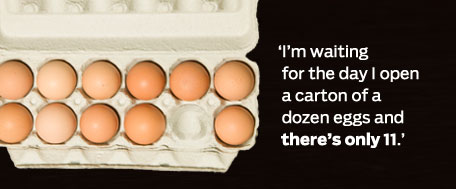Squat Box
Kellogg’s is testing a shorter, fatter cereal box. But unlike some recent package changes that have shortchanged consumers, this one doesn’t mess with the amount of product inside. The new packaging is expected to fit into pantries more easily and also save grocery shelf space, allowing retailers to offer a wider variety of products. Since it involves an 8 percent decrease in packaging materials, the new box also stands to burnish Kellogg’s green halo. Detroit will be the test market, and the study will last about six months, Kellogg’s says, before the company decides whether to roll it out nationwide.
Girl Scout cookie dilemma
The question over whether to raise the price or decrease the contents has hit the Girl Scouts as well. With the cost of ingredients like flour and cocoa up by 20 to 30 percent, the Girl Scouts of the USA said they were faced with either raising cookie prices or using cheaper ingredients. Instead, they chose to keep the price ($3.50 a box) the same but provide fewer cookies in those boxes of Thin Mints, Do-Si-Dos and Tagalongs. Also, the Lemon Chalet Creme cookies will be slightly smaller this year. —Candy Sagon
—Photo by Jupiter Images
It’s a trick worthy of a magician: Make a supermarket product look the same but actually contain less.
That’s the kind of move that many companies are using to shrink popular grocery items like mayonnaise, ice cream, peanut butter and toilet paper, while keeping the price and packaging the same. The result: Consumers are getting less for their money.
Approximately one-third of items at the grocery store have lost content since 2007, according to the Nielsen Co., which tracks market trends. For example, the Dial Corp. shaved its soap bars from 4.5 oz. to 4 oz.; the biggest jar of Hellmann’s mayonnaise dropped from 32 oz. to 30; and a tub of Breyer’s ice cream shrank from 56 oz. to 48.
Meanwhile, consumers last year saw food prices rise some 7 percent, according to the Bureau of Labor Statistics.
Companies argue that, like consumers, they’re also trying to stretch a dollar; their manufacturing costs have gone up, explains food marketing expert Phil Lempert, editor of SupermarketGuru.com. Factors like hurricanes, record cold weather and the rising cost of energy have driven up the cost of producing packaged goods.
“When you’re a food manufacturer, you either raise your prices even further or you take a look at putting less in the package and keep the price the same,†Lempert says. Still, he agrees that “some packages are blatant rip-offs.†For instance, he notes that coffee packages that may appear to be the same size “can have anything from 7.5 to 16 oz. of coffee, depending on the brand, and that’s just not fair.â€
Or consider how Skippy peanut butter now has an indentation at the bottom of its jars, causing the contents to drop from 18 oz. to 16.3, even though the jar looks the same. Practices like these cut across the grocery spectrum, influencing private labels and even organic products. “You especially see this with products like chips—organic or otherwise—especially when they’re packed in airtight bags,†says financial writer Jill Westfall, a contributor to Money magazine.
Part of the problem, says longtime consumer advocate Edgar Dworsky, is that most consumers “aren’t net weight-conscious, they’re price-conscious, and the manufacturers know that. That’s how manufacturers take advantage of customers. They do these tricks.â€
Dworsky, a lawyer who’s worked in the field of consumer protection for 31 years, monitors consumer news on his website ConsumerWorld.org, and recently started a blog, Mouseprint.org, that is focused on the fine print of advertising. He’s commented on the shrinking of Hellmann’s mayonnaise, as well as the downsizing in 2006 of Scott’s toilet tissue. That one was particularly sneaky, he says, because the company didn’t decrease the total number of sheets (1,000); it just reduced the length of the sheets from 4 inches to 3.7 inches, making the roll 300 inches shorter.
More recently, Dworsky noted that Kleenex tissues have shrunk in width by two-tenths of an inch, which adds up to more than 300 square inches less per box. Last August, he alerted his readers that StarKist’s Chunk Light tuna went from 6 oz. to 5.
“Manufacturers know that customers know the size [of a product] in the relative sense—when you pick up a large tub of margarine, which used to be 3 pounds but is now 45 oz.,†you can’t really feel the missing three ounces, he says.
Dworsky says that if shoppers spot a leading brand shortchanging them and it’s a recent development, they should check the other competing brands. Chances are, those brands haven’t changed yet and shoppers will get more for their money.
He also encourages consumers to shop as carefully as they can, clip coupons and voice their feelings to manufacturers of their favorite brands. “Send a letter and let them know you’re not happy about them changing the product,†advises Dworsky. “Maybe at least they’ll send you some discount coupons.â€
He also recommends that consumers “shop by unitâ€â€”that is, check the price per unit posted on the shelf to see what they’re really paying for.
Ultimately, though, once the top brands resize their packaging or contents, the other brands—even the private-label store brands—likely will change as well. And nothing seems safe. Dworsky says even dog food has downsized.
“I’m waiting,†he adds, “for the day I open a carton of a dozen eggs and there’s only 11.â€



